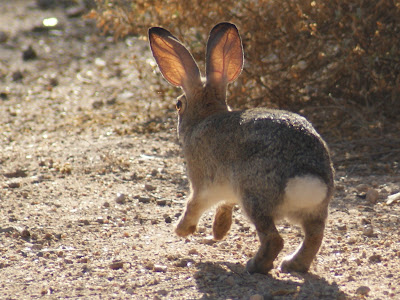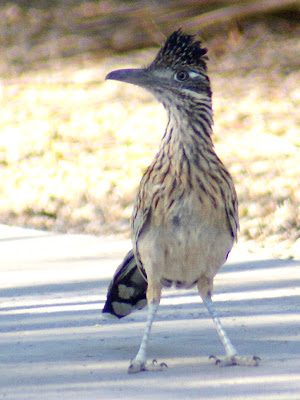.
From our relatives' house in Glendale it is only a couple of hundred yards to the start of a trail running along the edge of Thunderbird Park. The trail is hot and dusty at this time of the year but it is bordered by numerous cactuses and other desert plants. The ocatillos looked glorious when backlit by the sun.
Some barrel and similar cactuses were coming into bloom.
Even the creosote bushes were looking good.
Dominating all the other plants, though, were the saguaros cactuses, all of which have nesting holes carved and used by a range of bird species.
Some of the saguaros were in bloom, attracting both insects and birds.
As well as walking this trail, I several times drove the half-mile to the park's main parking and picnic area.
On every visit I saw cottontails galore, scampering off in front of me.
There were plenty of ground squirrels, too.
When people approached, the squirrels would run for the safety of their burrows but then they usually couldn't resist poking their heads up to see what was happening.
My target birds for the park were Curve-billed Thrasher, Cactus Wren, Abert's Towhee and Black-chinned Sparrow although I was also expecting to see more Gambel's Quail, Verdins and Greater Roadrunners. And I was hoping to see again the coyotes and the Long-eared Owl that we had seen on a previous visit.
Quail were everywhere, the males looking much more striking than the females.
There were many family groups, too, but the adults rapidly shepherded their offspring into cover as soon as I approached.
Curve-billed Thrashers were much less common but one obligingly posed on a saguaro.
On my last morning a family group of three Greater Roadrunners trotted across the road in front of my car but two of them disappeared before I could open the window and focus my camera.
There were Abert's Towhees under several of the picnic tables. Unfortunately, they refused to come out of the deep shade or to let me approach them.
Verdins hopped around chirping in many of the trees, their distinctive yellow crowns gleaming in the sunlight.
Among the many Mourning and White-winged Doves I saw a solitary Inca Dove.
I spent ages taking photos of Cactus Wrens, one of the most common and certainly the most brazen of the park's resident birds.
Our earlier trips to Phoenix had been in the winter and we had seen several Black-chinned Sparrows, to me the most beautiful of all the sparrows. However, June is not a good time to see this species and I wasn't surprised not to come across any on my first couple of visits to the park. On my third visit I was just telling Dee not to expect to see Black-chinned Sparrows when she pointed out a group of small birds hopping around in the scrub ahead of us. Black-chinned Sparrows! One of them hopped up onto a fence and stayed just long enough for me to get a photo.
So Thunderbird Park had turned up trumps again. Even though this year hadn't produced any coyotes or Long-eared Owls, I was more than satisfied by the species that did appear.
My Next Blog
Last Friday I left Glendale just after 5:00 a.m. and drove 90 minutes north to take part in a birdwalk at the Highlands Center in Prescott. I'll blog about this trip on Saturday..



























2 comments:
Jeff what a wonderful post. Great mixture of landscape, plant, Bird and mammal life... Love the head popping out of the burrow shot. Your post is a million miles away in both habitat and weatherwise to my last post.... and walk!
Love it
DAVE
Thanks, Dave. I'm glad you like it. I often get so focused on birds that I forget to photograph or blog about their habitat and the other creatures it contains.
Post a Comment